
HistoryofModernDanceStudentHandout
.pdf
THE HISTORY OF MODERN DANCE
Ballet Austin’s Michelle Thompson and Frank Shott
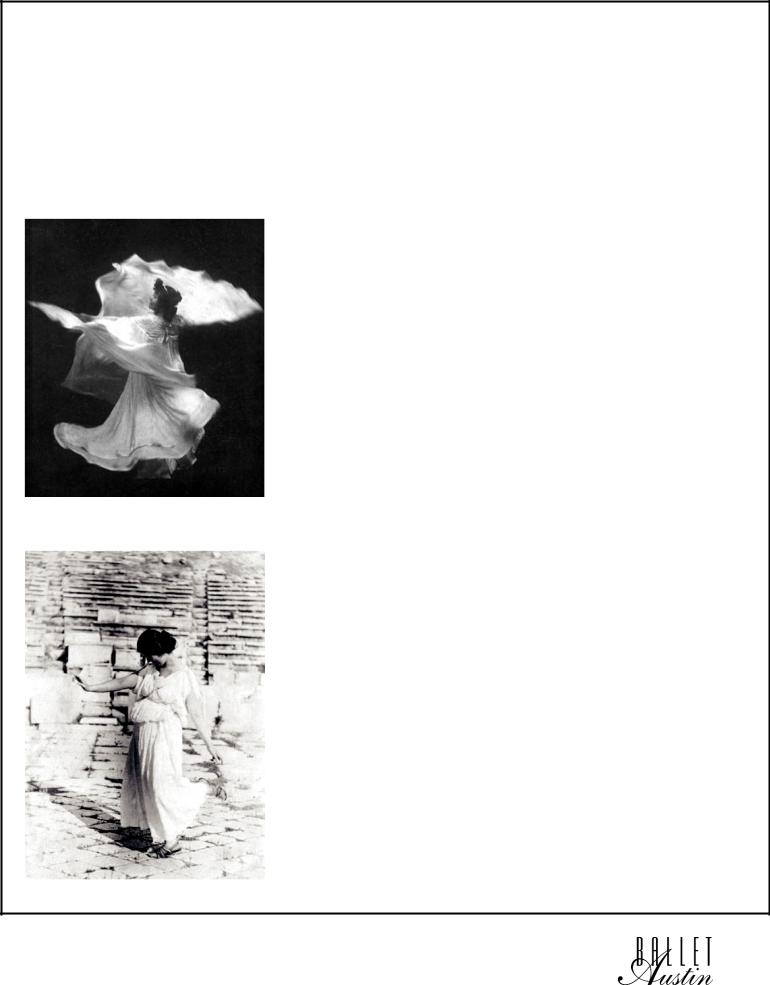
The Pioneers of Modern Dance
Modern Dance was born in America during the turn of the 20th century when a number of choreographers and dancers rebelled against the two forms of dance that were prevalent at the time, ballet and vaudeville. They rejected what they interpreted as the rigid and imperialistic nature of ballet, and they wanted to be taken seriously as artists rather than be seen simply as entertainers. Loie Fuller, Isadora Duncan, Ruth St. Denis, and Ted Shawn are considered to be the pioneers of modern dance in America.
Loie Fuller in La Danse Blanche circa 1896
Isadora Duncan at the Parthenon Theater
In 1891, Loie Fuller began experimenting with the effects of gas lighting on her silk costumes. Fuller developed a form of natural movement and improvisation techniques that were used in conjunction with her revolutionary lighting equipment and translucent silk costumes. Fuller was an inventor and stage craft innovator who held many patents for stage lighting, including the first chemical mixes for gels and slides and the first use of luminescent salts to create lighting effects. Most of the movement was performed with the arms, as Fuller had minimal dance training. She emphasized visual effect rather than storytelling or expressing emotions.
Considered the founding mother of American modern dance,
Isadora Duncan was largely self taught. She presented her first recitals in 1898, and by 1900 she was in Europe, where she would spend most of her remaining life and win the greatest acceptance.
Duncan was truly revolutionary. She discarded the corset, slippers, and tutu of conventional ballet dress, adopting instead tunics that freed the body and revealed its movement. She used music by Chopin, Beethoven, Gluck, Wagner, and other first rank composers. She danced on concert stages and in opera houses. She spoke of her dancing not as entertainment but as art with a high moral purpose. Most of all, she insisted upon the essence of dance as movement. Her vocabulary was simple but performed with a musicality, dynamic subtlety, and charisma that made it powerfully expressive. In 1904, Duncan established her first school of dance just outside of Berlin, where she began to develop her theories of dance education and to assemble her famous dance group, later known as the Isadorables. Between 1904 and 1907, Duncan lived and worked in Greece, Germany, Russia and Scandanavia.
Compiled and edited by Pei San Brown, Community Education Director, Ballet Austin pei san.brown@balletaustin.org or 512.476.9151 ext. 178
2

Ruth St. Denis was raised in a Bohemian environment and was encouraged to perform from a young age. She studied ballroom and skirt dancing, and was drilled in Delsarte poses by her mother. Her first professional job was as a variety act in 1894 at Worth’s Family Theatre and Museum in New York. Important early influences were her work with the eminent director David Belasco, eastern spiritualism and imagery, along with European travel. She called her dances translations
(ethnically inspired movement that included contemporary dance steps that became famous for their theatricality), which were inspired by
Eastern cultures and mythologies including those from India and Egypt.
Ruth St. Denis as a Hindu Dancer
By 1906 with Radha, St. Denis had found the essence of her distinctive dance style, which combined spiral form with equal parts voluptuousness, mysticism, and erotica. She built a stunning career as a soloist and, in 1914, acquired a professional and personal partner in Ted
Shawn. A year later the two opened Denishawn which, as a school and company, nurtured leaders of the next wave of modern dancers, including Martha Graham, Doris Humphrey, and Charles Weidman. St.
Denis was responsible for most of the creative work, and Shawn was responsible for teaching technique and composition. In 1933, Shawn founded his all male dance group, Ted Shawn and His Men Dancers, which was based at Jacob’s Pillow farm in Massachusetts. In 1939 St.
Denis published her autobiography, An Unfinished Life.
Ted Shawn in Mysteries of Dionysus
Ruth St. Denis and Ted Shawn circa 1920 |
Ruth St. Denis, Ted Shawn, and the Denishawn Dancers circa 1920 |
Compiled and edited by Pei San Brown, Community Education Director, Ballet Austin pei san.brown@balletaustin.org or 512.476.9151 ext. 178
3
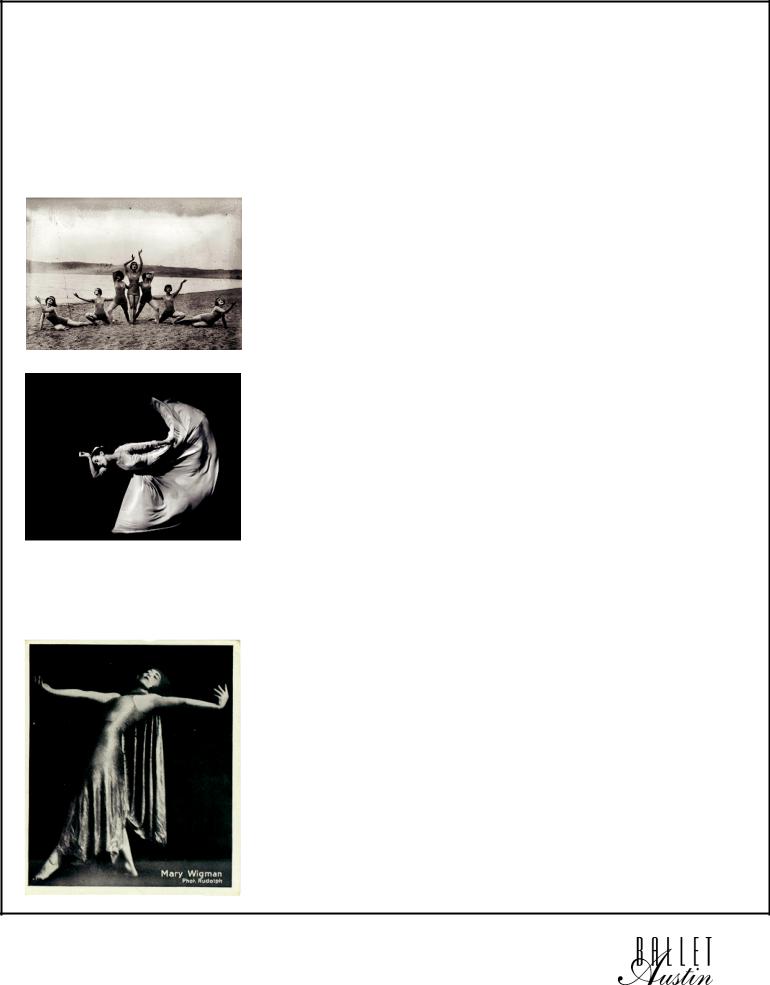
The First Generation of Modern Dance
During the 1920s, a passion for interpretive dancing swept America. Isadora Duncan’s fame and Denishawn’s tours had introduced audiences and dancers alike to the concept of a new form of serious theatrical dancing. The ground work had been laid for the first generation of modern dancers, who began developing the art as we know it today. This first generation included Martha Graham, Mary Wigman, Hanya Holm, Doris Humphrey, Charles Weidman, Agnes de Mille, and Lester
Horton.
In 1916, Martha Graham began studying at Denishawn. During the next seven years, Graham evolved from a student, to a teacher, to one of the company’s best known performers. She often worked as Ted Shawn’s partner, and became the co star of Xochtil, his famous duet about an Indian girl and an Aztec emperor.
In the late 1920s, Graham began working closely with Louis Horst,
Martha Graham (center), Denishawn Dancers who she had known when he was the musical director at Denishawn. Horst introduced Graham to the work of Mary Wigman, the German modern dancer who studied with Jaques Dalcroze and then with Rudolf von Laban. The style of dancing Wigman evolved was, in her words, mostly ʺdark, heavy, and earthbound.ʺ Her style was introduced to the United States in 1930 by her student, Hanya
Holm.
By 1930, Martha Graham had identified a new system of movement Martha Graham in Letter to the World (1940) she called contraction and release, which was based on her own interpretation of the Delsartean principle of tension and relaxation. This method of muscle control gave Graham’s dances and dancers a hard, angular look that contrasted with the smooth, lyrical bodily motions of Isadora Duncan and Ruth St. Denis.
Mary Wigman
Mary Wigman was the most highly regarded modern dancer and choreographer in Central Europe and one of the principal proponents of modern dance during the 1920s and ‘30s. Wigman’s choreography often employed non Western instrumentation such as bells, gongs, and drums from Asia and Africa. However, the primary musical accompaniment for her most well known dances was percussion, which contrasted greatly with her use of silence. Wigman also utilized ecstatic spinning in her choreography. She was concerned with fundamental human emotions, relationships, and superstitions. Influenced by non western and tribal motifs, Wigman’s costumes were simple, made with dark rough fabrics, and often included masks.
Compiled and edited by Pei San Brown, Community Education Director, Ballet Austin pei san.brown@balletaustin.org or 512.476.9151 ext. 178
4
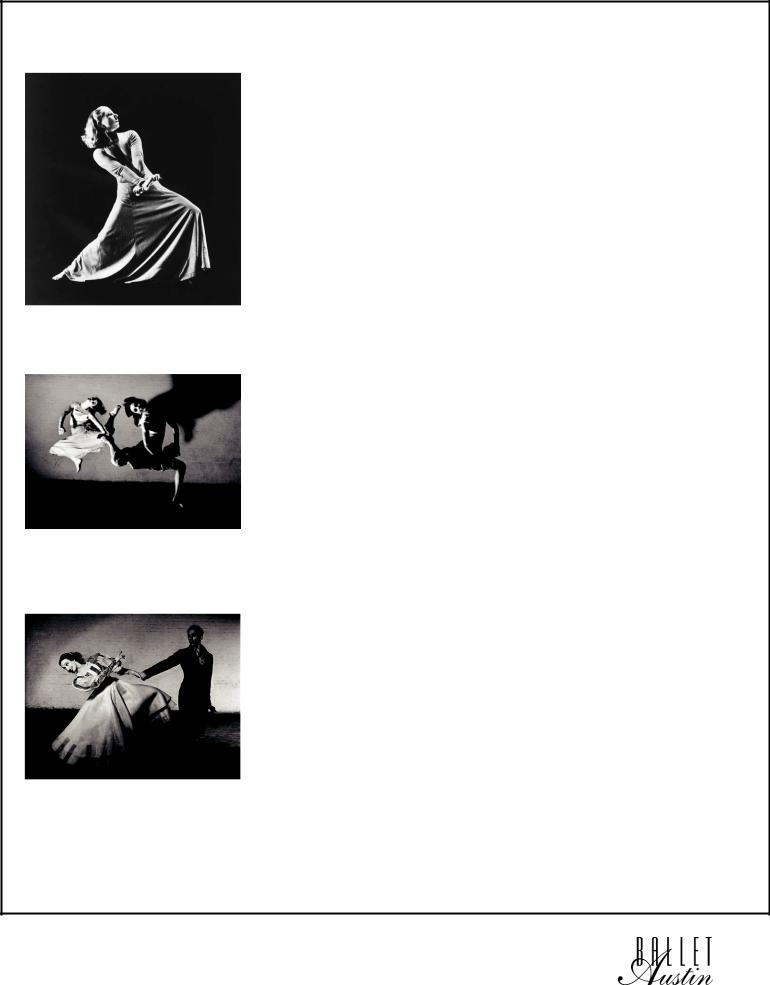
Hanya Holm
Doris Humphrey
Doris Humphrey and Charles Weidman, 1938
One of the legendary pioneers of American modern dance in the
1930s, Hanya Holm was born in Germany and studied at the Dalcroze Institute. She studied in the 1920s with Mary Wigman in
Dresden, eventually becoming a member of her company and chief instructor at her school. In 1931 Holm settled in New York to direct the Wigman Institute founded at the behest of Sol Hurok. In 1936, in response to rising antifascist sentiment, it was renamed the Hanya Holm School of Dance. She choreographed successfully on Broadway with dances for Kiss Me, Kate (1948), My Fair Lady (1956), and Camelot
(1960). Holm’s teaching emphasized space, and in choreographing, she made regular use of improvisation. Her theater work achieved a rare degree of dramatic and choreographic fusion.
Doris Humphrey was a choreographic master, theoretician, and creator of the technique known as fall and recovery. She studied at the Denishawn school in Los Angeles, where her teaching and creative abilities were quickly recognized. In 1928 she left Denishawn and gave her first independent concert with Charles Weidman, with whom she formed the Humphrey Weidman Studio and Company in New York. From the start her work demonstrated an unerring sense of form, as well as an interest in large scale abstract works. Her book,
The Art of Making Dances (1959), was based on her theories about dance composition.
Charles Weidman was inspired to become a dancer at fifteen after seeing Ruth St. Denis during a touring performance. In 1920, he received a scholarship to spend the summer studying at the Denishawn school in Los Angeles. Before the session had ended, Weidman was hired as a dancer for the Denishawn company. Weidman brought a very masculine approach to dancing that drew other men to the art form. His wit, kinetic pantomime (his own style of modern dance), and abstract movement added remarkable appeal to his dances. With Doris Humphrey, he founded the Humphrey Weidman Studio and Company in New York in 1928. When she retired from performing in 1945, he established the Charles Weidman
Theater Dance Company.
Compiled and edited by Pei San Brown, Community Education Director, Ballet Austin pei san.brown@balletaustin.org or 512.476.9151 ext. 178
5
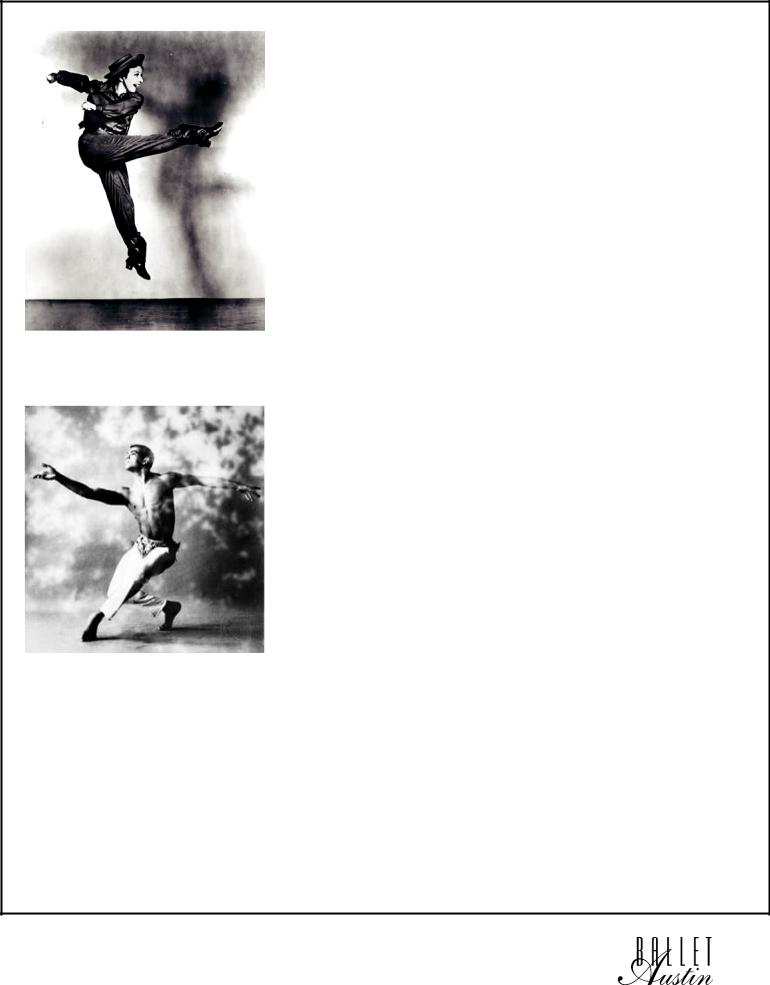
Agnes de Mille in Rodeo (1942)
Agnes de Mille made her solo debut in New York in 1928. In the 1930s in London, she studied with Marie Rambert, danced in the premiere of Antony Tudor’s Dark Elegies (1937), and worked on concert pieces that inspired her successes of the 1940s. Among these was Rodeo (1942), the Americana classic she choreographed for the Ballet Russe de Monte Carlo, and the dances for the Broadway musical Oklahoma! (1943). Oklahoma! was a turning point in Broadway history, and required training in ballet and modern dance. During the 1940s de Mille created a number of works for Ballet Theatre that revealed the light touch of her
Broadway choreography and the interest in American material that inspired her to form the Agnes de Mille Heritage Dance Theatre in the 1970s. A gifted writer, she is the author of several books, including a highly regarded biography of Martha Graham.
Besides early classes in ballet and Native American dance, Lester Horton studied at the Denishawn School. The Lester Horton Dance Group first appeared in 1932 and became noted over the ensuing two decades for an individual technique and theatrical style that embraced themes of social and political protest as well as satire. Highlights of his repertory include at least six versions of Oscar Wilde’s erotic Salome, Le Sacre du Printemps (1937). Horton also choreographed commercial projects and created the dances for nineteen Hollywood films. Companies such as Alvin Ailey American Dance Theater teach Horton technique.
Lester Horton
Compiled and edited by Pei San Brown, Community Education Director, Ballet Austin pei san.brown@balletaustin.org or 512.476.9151 ext. 178
6
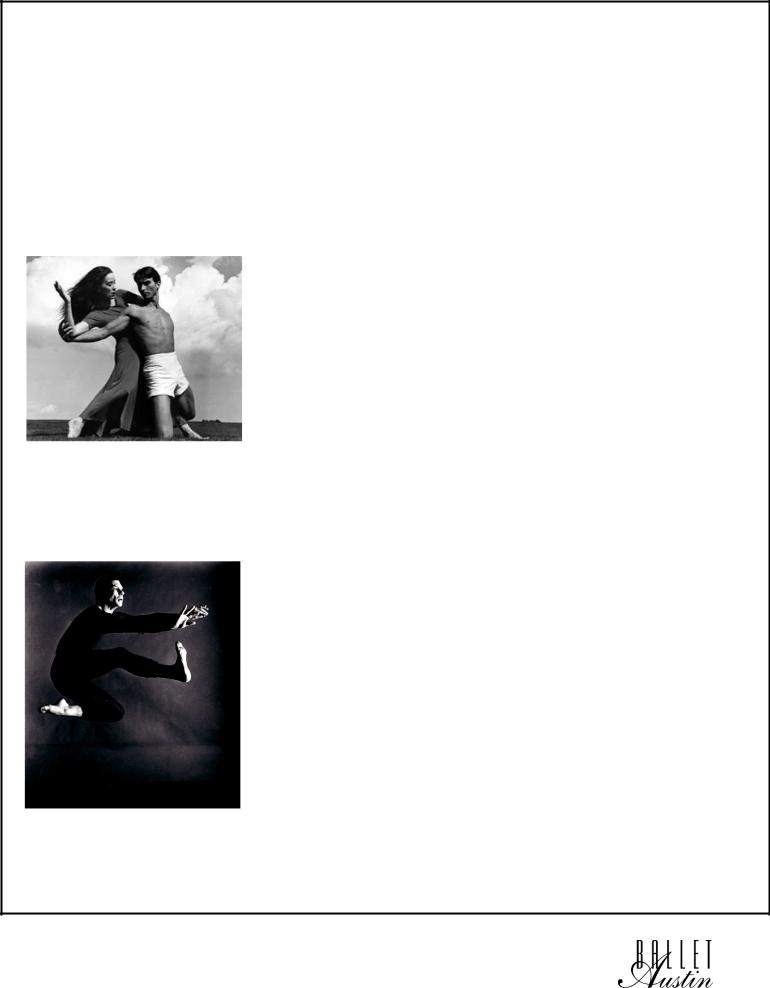
The Second Generation of Modern Dance
By the end of World War II the original founders of modern dance had produced a crop of talented students who set out to create their own kind of dance. The great battle for the position and respectability of modern dance had already been fought and won. It was not necessary for the second generation to take themselves or their art with the same deadly seriousness that had characterized their predecessors. The second generation of modern dance included artists such as Erick Hawkins,
Merce Cunningham, Paul Taylor, José Limón, Katherine Dunham, Pearl Primus, Alvin Ailey, Anna Halprin, Yvonne Rainer, and Twyla Tharp.
Erick Hawkins was a modern dance choreographer with an independent approach to movement based on natural kinesthetic response. After receiving his B.A. in classics from Harvard
University, he enrolled at the School of American Ballet, where he studied until 1938. At the same time he danced in George
Balanchine’s American Ballet and Lincoln Kirstein’s Ballet Caravan, for which he choreographed his first work, Showpiece (1937). In 1938 he joined Martha Graham’s company, becoming its first male member and the choreographer’s partner in numerous works including Appalachian Spring (1944). In his modern dance
choreography of the 1940s Hawkins first drew on Native American motifs; this intensified over the years, as did his interest in Daoist theory and Asian forms. He celebrated natural phenomena, made frequent use of masks, and developed a free floating technique that gave his dancing its characteristic lightness arid fluidity.
Merce Cunningham has been a dominant force in modern dance since the 1960s. Trained at the Cornish School, Mills College, and the School of American Ballet, he danced with the Martha Graham Company from 1939 to 1945, creating lead roles in a number of works, including Appalachian Spring. He began to present his own choreography in the 1940s and in 1953 founded what became the Merce Cunningham Dance Company. Those first concerts initiated a collaboration with the composer John Cage that lasted for five decades. Under Cage’s tutelage, Cunningham rejected psychological and dramatic content from his work. He experimented with chance procedures, worked closely with avant garde artists such as Robert
Rauschenberg and Jasper Johns, and developed a collaborative approach that insisted upon the autonomy of music, design, and
dance. Cunningham’s controversial choreographic methods and technique, which emphasized balletic leg action and flexibility of the back and torso, influenced generations of dancers and choreographers, beginning with the Judson group.
Compiled and edited by Pei San Brown, Community Education Director, Ballet Austin pei san.brown@balletaustin.org or 512.476.9151 ext. 178
7
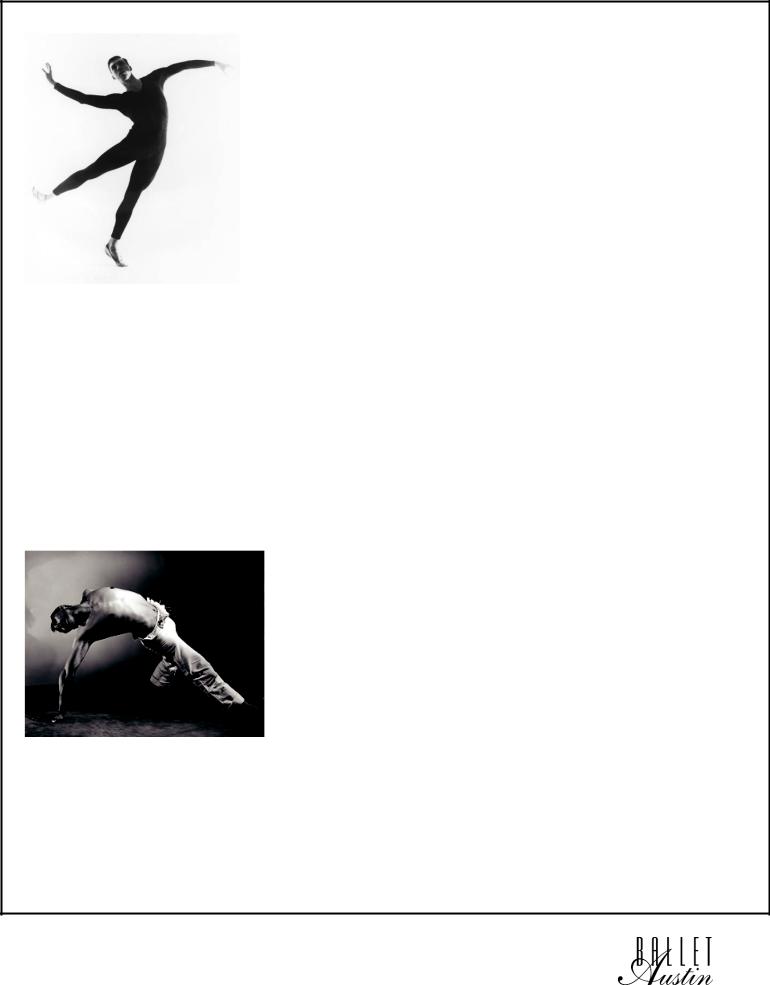
Modern dance choreographer Paul Taylor trained at the Juilliard School during the 1950s, and performed in works by Doris Humphrey, Charles Weidman, Merce Cunningham, Martha Graham, and George Balanchine. He was a soloist with Graham’s company from 1955 to 1962, even as he continued to choreograph and present works with his own company, which he founded in 1954.
Duet (1957) was an experimental piece in which Taylor stands next to a woman in street clothes, and neither one moves. This four minute piece called attention to posture and the interconnection of people within a space. His later pieces combine this minimalist performance with ballet. Among the best known of these are 3 Epitaphs, Orbs, The Book of Beasts, and Airs. His Aureole is one of the most highly
respected dance works of the time for its grace and technical difficulty. It is Taylor’s combination of the subtlety of ballet with the spontaneity of everyday gesture that has made him such a powerful force in modern dance.
Taylor’s works have a universal and long lasting appeal because, according to London’s Sunday Telegraph, ʺthey are about people, about the way they feel, the way they interact, and about their social institutions.ʺ His body language always carries an incredible range of motion, emotion, and imagination. He has developed a style that celebrates vigor, athleticism, and strength. Frequent collaborators have included painters Robert Rauschenberg and Alex Katz, and composer Donald York. He was the subject of the award winning documentary, Dancemaker.
José Limón was a crucial figure in the development of modern dance. His powerful dancing shifted perceptions of the male dancer, while his choreography continues to bring a dramatic vision of dance to audiences worldwide. Limón moved to New York City in 1928, and it was here that he saw his first dance program. “What I saw simply and irrevocably changed my life. I saw the dance as a vision of ineffable power. A man could, with dignity and towering majesty, dance... dance as Michelangelo’s visions dance and as the music of Bach dances.”
José Limón
In 1946, after studying and performing for 10 years with Doris Humphrey and Charles Weidman, he established his own company with Humphrey as Artistic Director. Limón’s choreographic works were quickly recognized as masterpieces and the Company itself became a landmark of American dance. Many of his dances are considered classics of modern dance. In 1997 he was inducted into the National Museum of Dance’s Hall of Fame in New York. His autobiographical writings, An Unfinished Memoir, were edited by Lynn Garafola and published in 1999.
Compiled and edited by Pei San Brown, Community Education Director, Ballet Austin pei san.brown@balletaustin.org or 512.476.9151 ext. 178
8
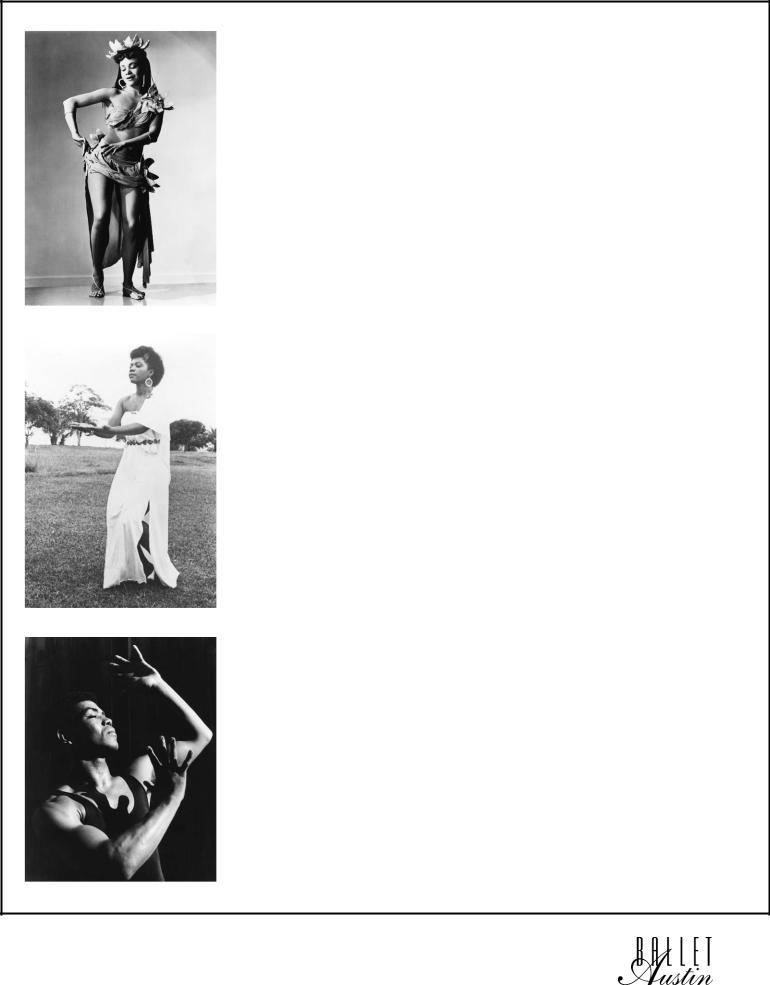
The grande dame of African American dance, Katherine Dunham, studied anthropology at the University of Chicago. In 1935 6, with support from the Rosenwald Foundation, she spent eighteen months investigating the dance cultures of the Caribbean. This research became the basis for the African American style she was then developing.
Settling in New York, she appeared at the 92nd Street Y, and with her company took part in the 1940 Broadway hit Cabin in the Sky, choreographed by George Balanchine. In the 1940s her preferred format was the revue, which introduced audiences around the country to the best of African American dance talent. Her technique, which drew on movements from the Pacific as well as Africa and the Caribbean, led toward an experience of total rhythmic immersion. In 1966 she began a long association with Southern Illinois University.
Katherine Dunham
Pearl Primus, dancer, choreographer, and outspoken advocate for
African dance, received a scholarship from the New Dance Group and in
1943 made her debut at the 92nd Street Y. She studied African and African American material, and developed a repertory of dances emphasizing the rich variety of African diasporic traditions. In 1948, she received a grant to collect material and document dances in Africa that in some cases were fading into history. Back in New York, she opened the Pearl Primus School of Primal Dance. In 1961 she became the director of the African Performing Arts Center in Monrovia, Liberia, the first organization of its kind in Africa. A buoyant and charismatic performer, Primus lectured widely and taught courses in anthropology and ethnic dance on many campuses. She once said ʺI dance not to entertain, but to help people to better understand each other.ʺ
Pearl Primus
Alvin Ailey
Alvin Ailey began his dance training as a teenager with Lester Horton in Los Angeles. He danced on Broadway and made appearances with
Sophie Maslow, Anna Sokolow, and Donald McKayle. He founded Alvin Ailey American Dance Theatre in 1958 as a repertory ensemble for modern dance classics and new works by Ailey and others. In 1960 he choreographed Revelations, a beloved modern dance classic. Cry (1971), the solo dedicated to “black women everywhereʺ that made Judith Jamison a star, was set to gospel music. In the 1970s Ailey choreographed several works to music by Duke Ellington, a favorite composer. Ailey’s best works drew on African American traditions and subject matter, and AAADT is one of the country’s outstanding companies as well as a showcase for African American talent.
Compiled and edited by Pei San Brown, Community Education Director, Ballet Austin pei san.brown@balletaustin.org or 512.476.9151 ext. 178
9

Anna Halprin in The Prophetess (1950)
Yvonne Rainer
Anna Halprin was a pioneering dancer and choreographer of the modern dance movement. She founded the San Francisco Dancer’s Workshop in 1955 as a center for movement training, artistic experimentation, and public participatory events open to the local community. Halprin has created 150 full length dance theater works and is the recipient of numerous awards including the 1997 Samuel H. Scripps Award for Lifetime Achievement in Modern Dance from the American Dance Festival. Her students include Trisha Brown, Yvonne
Rainer, and many others.
Yvonne Rainer began training as a modern dancer in New York in l957 and began to choreograph her own work in l960. She was one of the founders of the Judson Dance Theater in l962, the genesis of a movement that proved to be a vital force in modern dance in the following decades. Rainer pioneered the use of improvisations based on ordinary, non dance movements ranging from acrobatics, to military marching, to sports and games. Some of her better known dances and theater pieces are Terrain (1963), The Mind is a Muscle (1968), Continuous Project Altered Daily (1969 70), This is the story of a woman who... (1973), and After Many a Summer Dies the Swan (2000), which was commissioned by the Baryshnikov Dance Foundation.
Twyla Tharp
Twyla Tharp’s early training included a variety of performing arts including ballet, baton twirling, and the study of several musical instruments. Her signature technique is similarly eclectic, integrating classical discipline and vocabulary with the avant garde.
Tharp has choreographed for dance, theater, film, television, and video. Her selection of musical composers has been equally broad, ranging from classical masters to jazz and pop superstars. Tharp’s aesthetic evolved during the highly experimental 1960s. She joined the Paul Taylor Dance Company in 1963, but left two years later to form her own company. She received early accolades for The Fugue (1971), which uses no music but is accompanied by sounds made by the dancers. Two years later she choreographed Deuce Coupe (1973) for the Joffrey Ballet to songs by The Beach Boys.
Compiled and edited by Pei San Brown, Community Education Director, Ballet Austin pei san.brown@balletaustin.org or 512.476.9151 ext. 178
10
